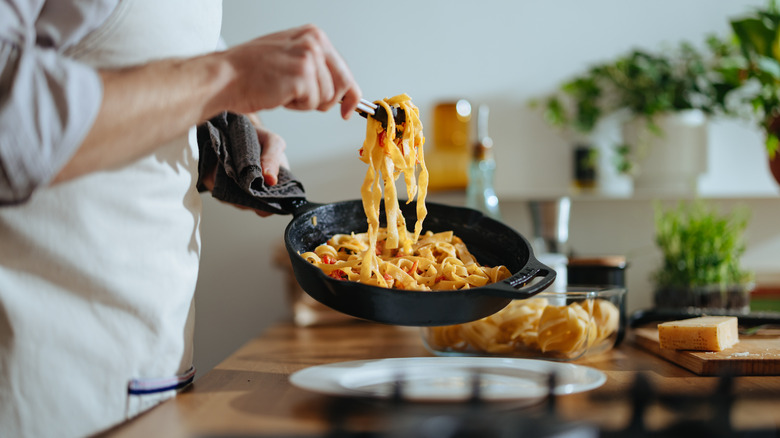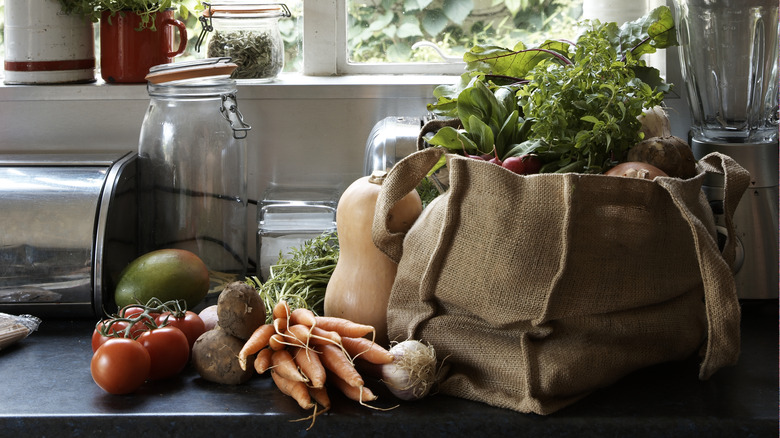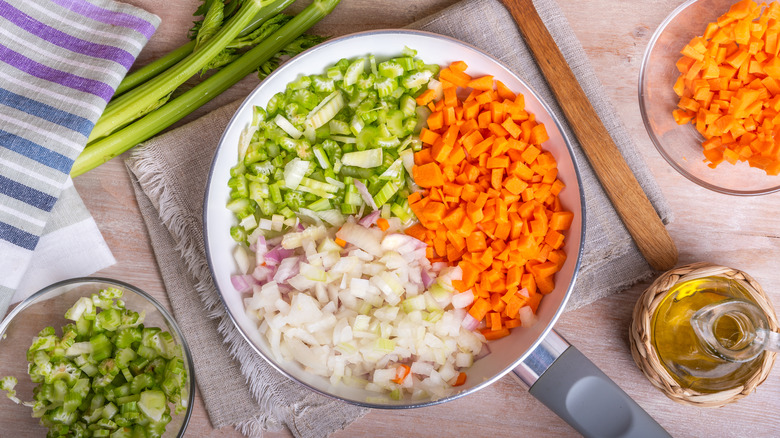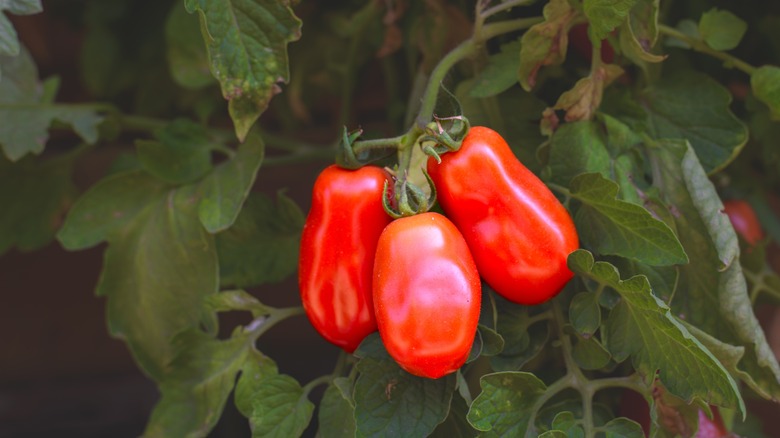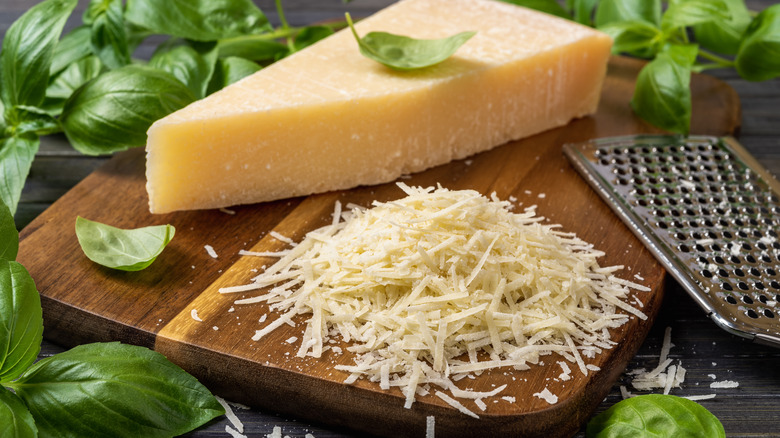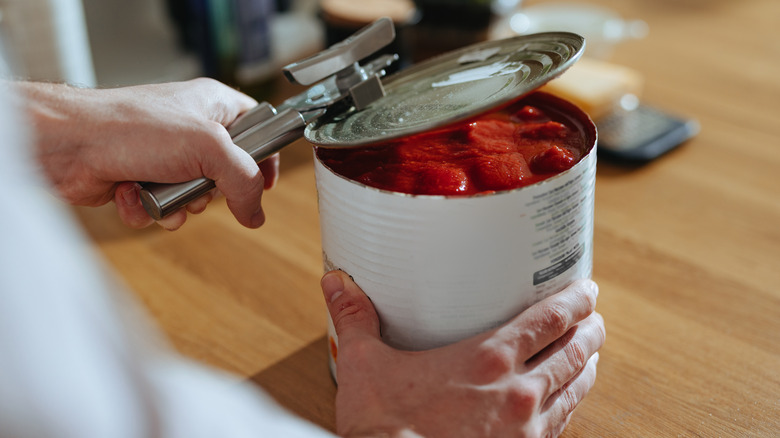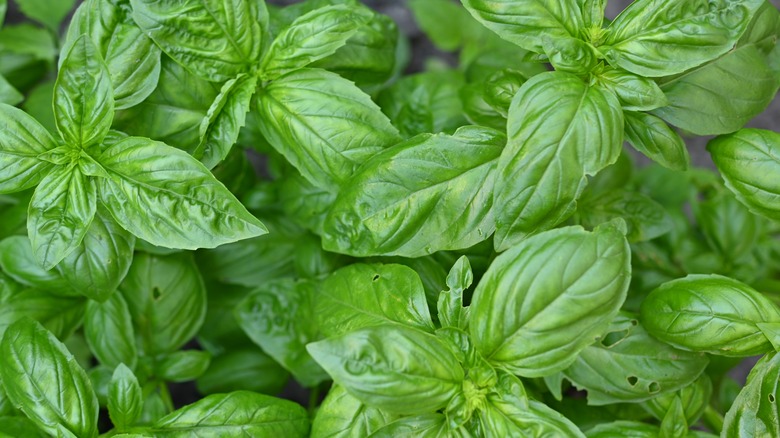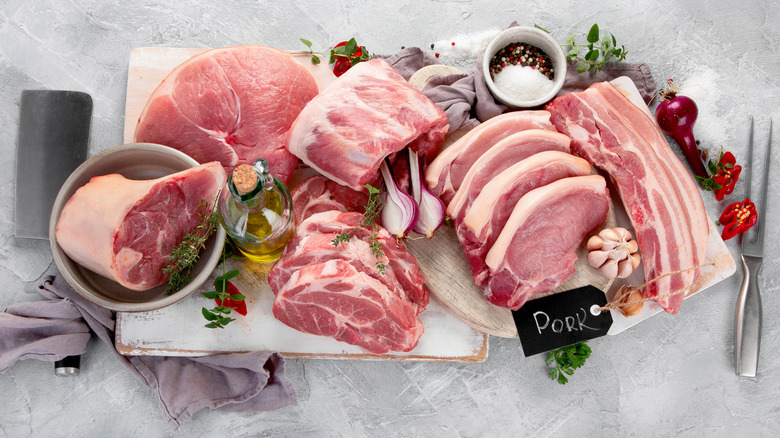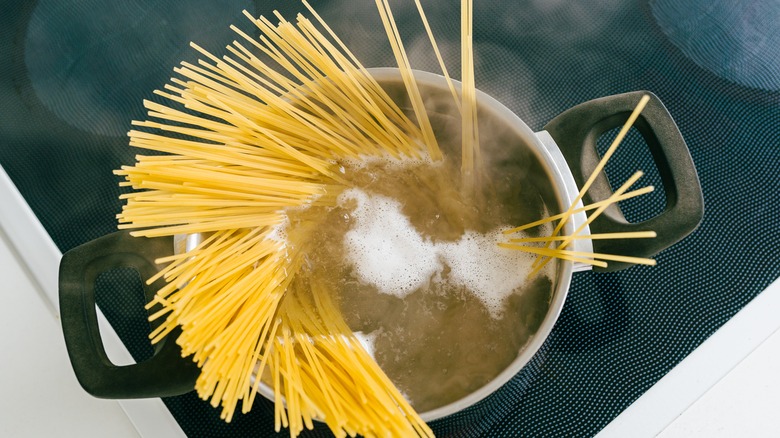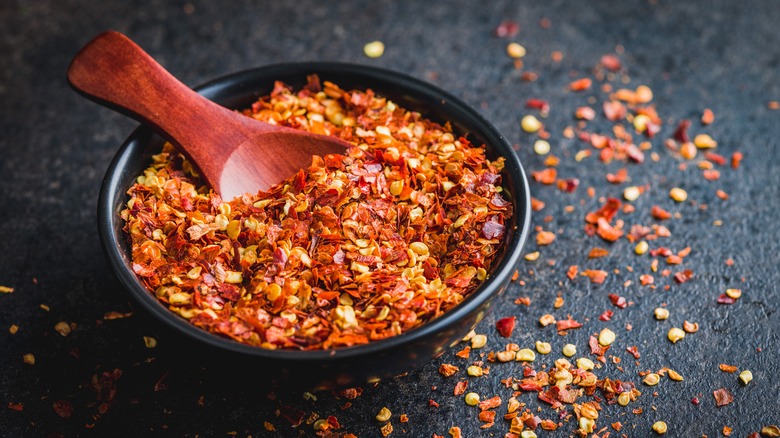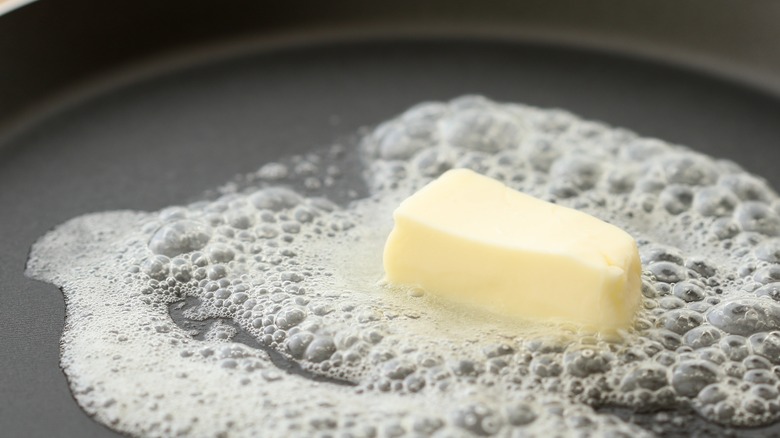12 Tips You Need When Making Homemade Pasta Sauce
When it comes to simple, homemade dinner options, one meal will always reign supreme — pasta in a delicious sauce. Quick, easy, and incredibly satisfying, pasta is the versatile yet scrumptious dish you can default to when your pantry is empty or you're fresh out of ideas. But as tempting as it is to buy jarred sauce at the grocery store and save it for a rainy day, there are many advantages to mastering your own homemade pasta sauce.
Even when you're low on ingredients, you can craft a simple, tasty pasta dish with the few items you have in stock, making for a sauce that will always run miles around the jarred stuff. That's because the fundamentals of Italian cooking rely mostly on a few simple, nutrient-rich ingredients that you likely already have in your kitchen. In the end, you'll save both time and money, resulting in a tasty meal that requires less effort than you may think. If you've never ventured into fresh sauce territory or simply want to add a more authentic touch to your favorite recipes, these are a few solid tips to consider next time you get that salt water boiling. Once you master the art of the sauce, you'll never reach for the jar again.
Use as many fresh, seasonal ingredients as you can
When it comes to perfecting the art of Italian-inspired pasta sauces, there is one rule to always follow: the simpler the better. All Italian cuisine is rooted in fresh, seasonal ingredients that already taste delicious, and therefore require a lot fewer additives to make a scrumptious end product. Think about it — if you're looking to make a basic all-purpose tomato sauce, all you really need is summer-ripened tomatoes, some extra virgin olive oil, and salt. If you want to get fancy, you can add in some fresh basil, or a bit of garlic to make it a marinara sauce, but that's truly all it takes to capture a tomato's delicious flavor.
And fresh, simple ingredients don't just taste better — they're also way better for you. Frozen or canned foods tend to be more processed than their fresh counterparts, reducing their overall nutritional value. The less you tamper with a fresh fruit or vegetable, the more you'll be able to reap its nutritional benefits. So yes, contrary to popular belief, a pasta dish can make for a well-rounded meal when fresh ingredients are involved.
Start your sauce with a soffrito, especially when making meat sauce
Craving a Bolognese over some perfectly al dente pappardelle? Then start the base of your sauce with a soffrito, also known as a mirepoix in French cooking. There's a reason chefs make most sauces, stews, and other hearty liquids with a soffrito — the technique dates back to the 18th century and is a massive game changer for your pasta sauce. Instead of sauteing your choice of meat in olive oil or butter and then adding in the tomato sauce or paste, starting with a soffrito adds a host of aromatics to your sauce that make for a more nuanced flavor profile.
In a classic Italian soffrito, you'll need to start your base with finely chopped onions, celery, diced carrots, and minced garlic. Add these veggies to a pot of olive oil and allow them to simmer before putting your meat into the sauce. These aromatic vegetables will add a subtly sweet, rich background flavor to your bolognese that will ultimately elevate every bite. If you'd like to experiment, you can even add veggies like mushrooms, parsnips, leeks, or peppers to your soffrito to experiment with a host of different flavors.
If using canned tomatoes, always look for San Marzano
If you've ever entered an Italian kitchen, chances are you've heard what a big deal the San Marzano tomato is. Just like Parmigiano Reggiano, San Marzano tomatoes have D.O.P. status in Italy, a distinction that confirms a food product was grown and produced in a specific region to prove its authenticity. So what's so special about this tomato and why should you hunt it down on your next trip to the grocery store? Simply put, it's the best tomato you can use for sauce.
San Marzano tomatoes are a type of plum tomato that look similar to the Roma variety but with a pointed bottom. Because San Marzano tomatoes have fewer seeds and thicker outer walls, they prove to be meatier and less watery than other varieties available, resulting in a robust tomato flavor that is perfect for sauce. San Marzano tomatoes also tend to be sweeter with a nice acidic bite, meaning you won't have to add any additional sugar to your sauce to balance out the flavors. While San Marzano tomatoes can be difficult to find fresh, buying them canned at the grocery store — especially whole canned tomatoes — will offer a comparable fresh, tomato-y punch that you're looking for.
Save your Parmesan rinds to add to your sauce
Speaking of D.O.P. treasures, let's take a second to talk about Parmigiano Reggiano. If you manage to get your hands on a wonderful wedge from that magic wheel of nutty, crystalized goodness, save every bit of it. That's because every part of the cheese, even the rind, can find a home in your sauce and skyrocket its flavors.
Whether you're using Parmigiano Reggiano or classic Parmesan (yes, they are two completely different things), the hard exterior known as the rind can serve a purpose in whatever sauce you're stewing up. Simply take the rind and add it to your sauce as it simmers, then be sure to remove it before serving your pasta. Even without adding any bit of cheese to your sauce, you'll still get the salty and nutty flavors the cheese offers your dish. The best part of using the rind in your sauce? You can save the rest of the cheese for a generous sprinkle on top of your pasta when it's finished.
Buy canned whole tomatoes, then squeeze them yourself
While using fresh ingredients in your sauce is a great rule of thumb to follow, there is one exception to the rule: Using canned tomatoes can actually be better than using fresh tomatoes. While fresh tomatoes can add sweetness to your sauce, they're often too watery to pack the serious tomato-y flavor that you're trying to achieve. That's often why fresh tomatoes are used in a recipe in conjunction with other ingredients to boost its flavor. Fresh tomatoes also don't make for a smooth, thick sauce, which is another thing to keep in mind.
Canned tomatoes, however, often supply a lot more flavor to your sauce because the canning process concentrates the tomato flavor better. If you don't like many seeds, skin, or pulp in your sauce, it's best to look out for canned tomato puree or passata, as it's referred to in Italian. However, if you want the closest thing to a fresh tomato flavor, opt for canned whole tomatoes then squeeze them by hand or with an immersion blender to create a chunky or smooth sauce. While canned whole tomatoes may require a bit more work, there is a noticeable flavor difference. During the canning process, the whole tomatoes are cooked very lightly, then the skins are removed and the tomatoes are packed in concentrated juice. As a result, they're the closest to fresh tomatoes that you'll find on the shelf, making for a juicier, richer sauce.
Always have fresh basil on hand
Just like San Marzano tomatoes and Parmigiano Reggiano, fresh basil is an Italian staple for tomato sauces and many other pasta sauces beyond it. While last-minute substitutions can be made if you don't have basil on hand, there's nothing quite like the flavor of the freshly picked green leaf added to your dish.
That's because fresh basil has the ability to lift a dish without overpowering it. Packed with a mildly peppery, sweet, and slightly citrusy flavor, basil can add some much-needed freshness to your sauce, especially when you opt to use canned tomatoes. The best way to have unending access to fresh basil is to grow it yourself, although most grocery stores will sell fresh basil leaves or plants if you don't have the greenest of thumbs.
Basil also has many applications beyond tomato-based sauces. A delicious, simple pesto is another incredible sauce option with which to top your pasta or use for sandwiches or salads. A word of caution on the pesto front, though — unlike most sauces, pesto should never be cooked. Cooking pesto causes the fresh basil leaves to become burned or bitter. Fortunately, that's one less step when it comes to making that sauce. To truly get the best, most authentic pesto, combine your ingredients with a mortar and pestle, then add it to your pasta once it has finished cooking.
Mix up the type of meats you use
Whether you're making a simple ragu or a classic Bolognese, make sure to choose the type and cut of meat you want to add to your sauce carefully, because meat can have the greatest impact on a sauce's overall flavor. That's why it's always a good idea to choose more than one type of meat for your sauce to reap all the possible flavor benefits each meat has to offer.
If you're opting for a Bolognese, for example, most classic recipes call for both ground pork and ground beef mixed together — with a soffrito, of course — to add rich layers of fattiness and depth to your sauce. Other ragus may have three or more types of meat, typically utilizing pork, beef, lamb, or veal to achieve the desired flavor profile. Cured meats can also be added to the mix, with options like pancetta or guanciale giving much-needed fat with some saltiness. If you really want to make your sauce into a hearty meal, you can even add braciole, a roulade-style meat, typically stuffed with prosciutto, breadcrumbs, and Parmesan, to create even more dimensions in your sauce.
Regardless of what types of meat you decide to choose, always opt for cuts with a decent amount of fat. Meats that are too lean can dry out your sauce, while fat will add the richness you're looking for.
Pasta water is your new secret weapon
It's time to ditch that colander because pouring your leftover pasta water down the drain could mean sacrificing the one ingredient that will skyrocket your sauce to new heights. If you've never taken a ladle of the murky, remaining liquid sitting in the pot after your pasta finishes cooking and added it to your sauce, it's time to be awakened to a little-known truth. Once you realize your best secret ingredient was sitting in front of you this whole time, that is when your life in pasta nirvana finally begins.
That's because leftover pasta water is rich in all the starch your pasta released while it was cooking, in addition to the salt you added to the water to start. That heady brew, when combined with whatever fat you're using to cook your sauce, be it butter, olive oil, or animal fat, mixes together to emulsify right there in your pan. The result is a silky smooth sauce that looks and tastes like something you'd get from a restaurant. While it's important not to flood your sauce with cups full of leftover water, a few ladles, depending on how much sauce you're making, should suffice to get the shiny richness you're looking for.
All wines are welcome
The best beverage to pair with a steaming plate of pasta also happens to be the best beverage to add to your pasta sauce. Both white and red wines can be used with any type of pasta sauce to take flavors to the next level, it's just a question of when to use which type. The first rule of adding wine to any dish is to make sure it's a wine you actually like. While you may not want to pour your favorite bottle away into your bubbling ragu, you'll enjoy your sauce a lot more if you steer clear of adding wines you would never actually drink.
A sauce that can always use a little wine? A Bolognese. While there's still some debate on whether white wine or red wine belongs in your bolognese, you can opt for either depending on the flavors you're looking for. Many classic Italian recipes will call for a subtle white wine to be added to bolognese to not overpower the flavors of the meat. A bold red, however, pairs well with the sauce when you're looking to simmer it for longer and allow the wine to render.
Most white-based sauces, whether they're using cream or butter, however, can benefit more from a white wine. Pastas with fish, like spaghetti alla vongole, are particularly delicious when you add a dry white wine to the mix to complement any added citrus or parsley already in the sauce.
Don't be afraid of some heat
Spice is a quick and easy way to introduce new flavors to your dish and can be the simplest way to transform your sauce into something new. For nights when the basic tomato sauce is no longer cutting it in your dinner rotation, try its spicy cousin, the arrabbiata sauce. Arrabbiata sauce is the exact same as a tomato sauce in all ways but one: the addition of dried pepper flakes to add an extra bite. Just how spicy the sauce can be is ultimately up to you, but a teaspoon of dried flakes is a good place to start and build up from.
Another good way to add heat to your dish is to experiment with Calabrian chili paste, a much-loved ingredient in Italy. Bucatini all'Amatriciana, a classic Roman dish, combines the spice of Calabrian chili peppers with fatty guanciale and acidic tomato in one simple sauce that is easy to make and tastes exquisite. You can also add Calabrian chili to your favorite vodka sauce recipe for an added zing.
Try butter instead of (or with) olive oil
Butter can never be wrong, right? Instead of reaching for the extra virgin olive oil to get your sauce started, mix it up with a bit of butter. You can even use both butter and extra virgin olive oil together if you want to take advantage of both flavors in your dish.
Much like pasta water, butter can act as an emulsifier when used in sauce, adding shine and a smooth, silky texture that makes for a decadent pasta dish. Chances are when you go to a restaurant and your pasta comes to your table with an almost glossy finish, it's likely because the chef added butter. You can use butter in any type of sauce, from a regular tomato sauce to a creamy vodka sauce or basic cream sauce. Butter can even be a sauce on its own, with brown butter and sage making for the perfect fall-flavored sauce to pair with ravioli. The sky is truly the limit on how butter can play a part in your sauce.
Go beyond Parmesan
Keep the Parmesan around when it's time to sprinkle some cheese on your finished pasta, but when making sauce, experiment a little. You'll often find that different recipes will call for different types of cheeses outside of Parmesan, and ignoring those directions in favor of your go-to grated cheese can seriously impact the flavor of your dish.
Take carbonara, for example. Classic carbonara recipes call for Pecorino Romano cheese, both because it's local to Rome where the dish originally came from, and because it adds necessary saltiness that complements the fattiness of the guanciale and eggs. Grana Padano is another type of cheese you might see used as an alternative to Parmesan. Like Parmigiano Reggiano, Grana Padano is a nutty, grainy cheese featuring crystallized salt, but it's often a bit more affordable to buy at the grocery store. You can use Grana Padano in place of or alongside Parmigiano Reggiano in recipes like bucatini cacio e pepe.
